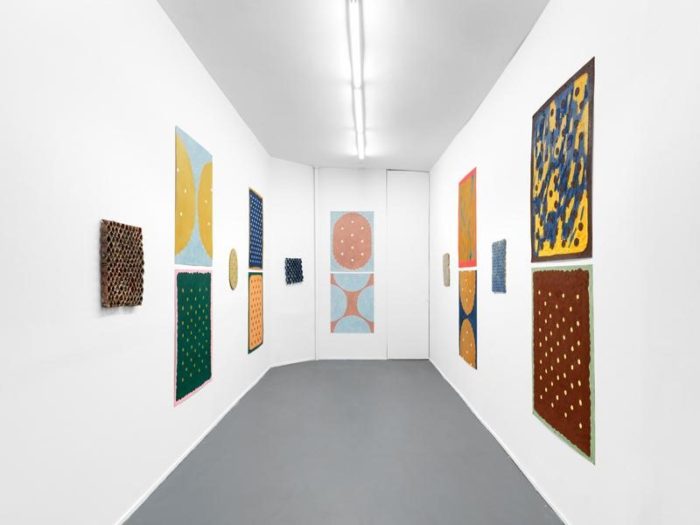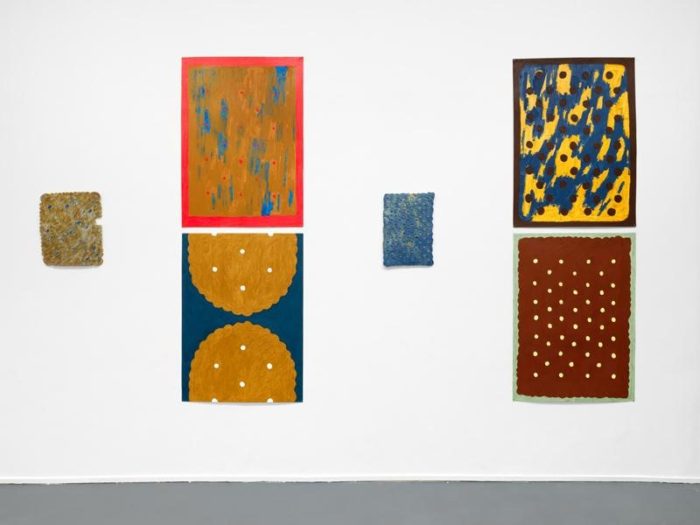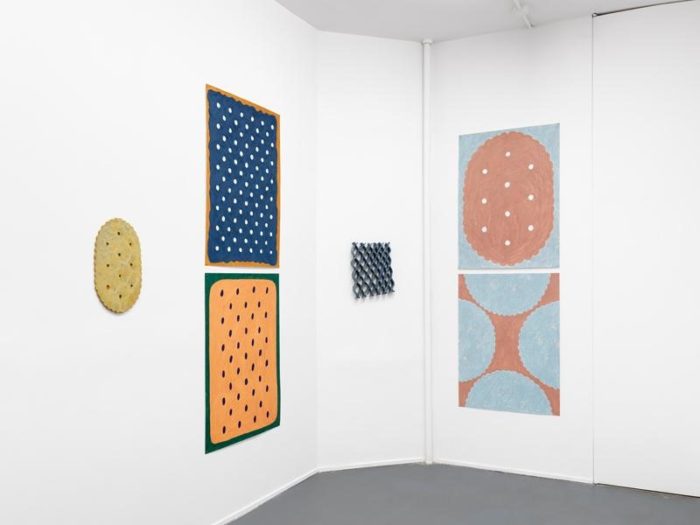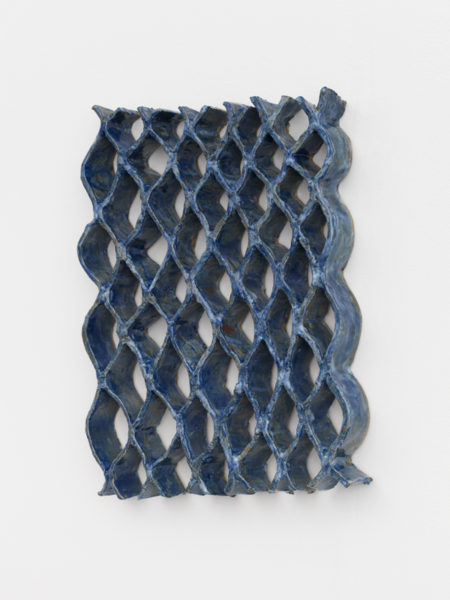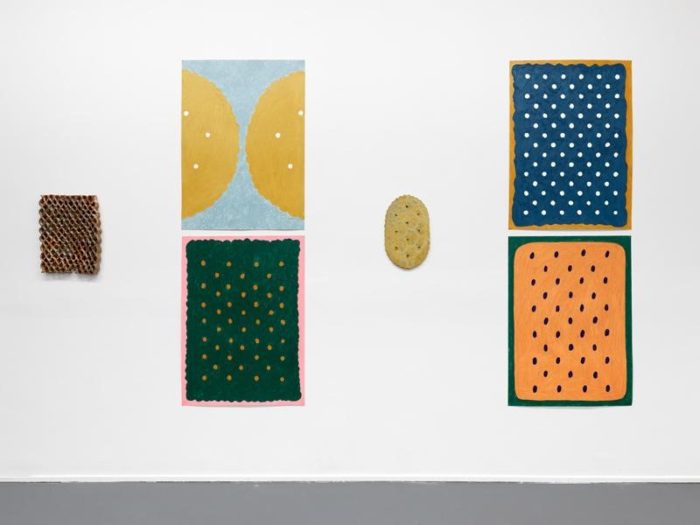
Rachel Domm’s exhibition titled Premium, Original, & 100% Fat-Free weaves a narrative that is at once intimately profound and delightfully mundane. The works derive their shape from supersized proportions of prosaic objects such as crackers, embroidery, and packing material. Having chosen a most pedestrian subject, Domm has created an impressively sophisticated body of work. Against pop-y shades of melon, persimmon, blue, and pink, she poetically paints and sculpts the ribbed edge of a Ritz. Another commonly used Pop trope is employed in both her ceramics and paintings on paper: the polka dot. Domm traces the history of these works to eating a snack while pondering feminism and personal experience in marketing.
For the occasion of Domm’s show, I decided to find out more about the thinking behind this group of delectable works. Below Domm answers a few of my questions.
David Sanderson: Your current exhibition is titled “Premium, Original, & 100% Fat-Free.” Artworks reference crackers, embroidery, and packing material. How did you arrive at the use of this imagery?
Rachel Domm: I think it was because of a late night snack. Honestly, it did come from holding up a cracker and realizing it was an interesting shape with similar repetitive patterns, curves and angles that a handmade object might have (like a rug or basket, which were previous series of mine). The ceramic wall pieces that reference embroidery and packing material come from a long-held goal to make work that references textile patterns but is more sculptural and/or made with materials that are different than the source. For example, ceramic is hard but yarn is soft so making a solid ceramic piece based on a knitting patterns brings a new dimension to that pattern.
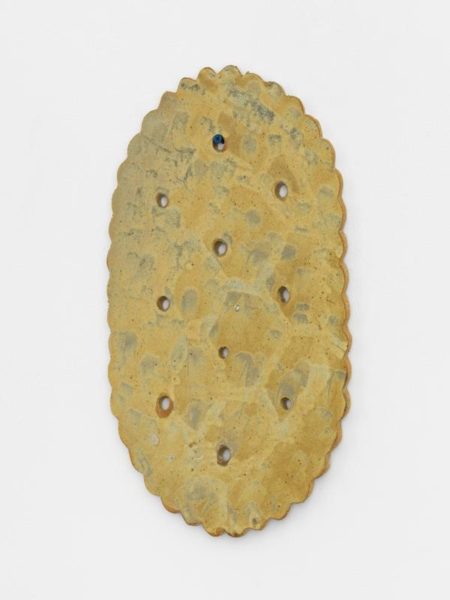
DS: Have you always looked to everyday objects or is this something new?
RD: Everyday objects, handmade items and craft have been themes in my work for several years. I am really interested in our sense of self that we connect to things we consider ours or that we create. Objects can be glimpses into or our inner emotional lives or, in the case of exalted objects such as talismans or heirlooms, inspire magical thinking that is an escape from the banal and gives us a sense of control. We often prize our possessions or creations because we believe they have a unique essence of ourselves within them. Any object can become interesting to look at or explore once you decide to imbue it with meaning.
DS: How do you place your work in the context of feminism? In your show, you combine ceramics and paintings on paper. I think of Miriam Schapiro’s work of the 1970s that combined fabric, paint, and other materials through “traditional women’s techniques – sewing, piercing, hooking, cutting, appliqueing, cooking and the like…” Is this how you are approaching the work today?
RD: By giving significance and presence to techniques and objects connected to the feminine sphere, it helps bring the feminine out of the second place status its currently possess in most of the world. I used to feel embarrassed if someone said my work looked feminine—it felt like a veiled insult and something to work against. But I had to check myself and realize that if I wasn’t embracing the feminine as a positive thing, then I wasn’t advancing the place of the feminine in the world. Instead, I was just another person shamed by their femininity, thus perpetuating the first place status of all things masculine. And you need both to be a full human and to have a fully human society.
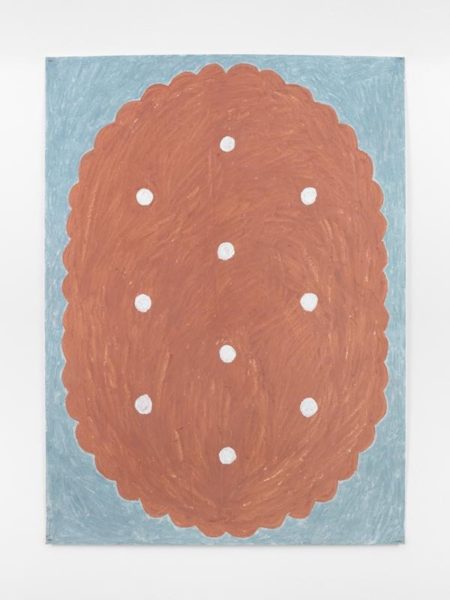
DS: I just watched an interview with another young contemporary ceramicist, Genesis Belanger. She speaks about advertising’s use of “visual language to manipulate us and our desires with a lot of intention.” Her goal of tapping into advertising’s “lusciousness” seems to appear in your work as well. Have you ever worked in advertising?
RD: First of all, I love her work—it’s a complete visual treat and a biting commentary on the role of products in our lives. I was an illustrator and designer for 10 years before I realized it wasn’t where I wanted to go. In addition to doing illustrations in something like 70 New Yorkers (I always like to tell people that so being a late-blooming artist seems preceded by something else), I also did campaigns for many large companies and sat in on many marketing meetings. You can’t escape the capitalist machine entirely and art can still become a product, but I didn’t feel good with my place in the consumer-producer machine. Marketing is shameless in its efforts to hook people into consuming and I didn’t want to solely harness my creativity and ideas towards that. I still do some design work because I have to make ends meet but I feel better that I am also making work that isn’t primarily meant to sell anything (except maybe itself but it can also just exist to be looked at).
DS: You worked at Printed Matter when AA Bronson was the director. The independent bookstore, artist organization, and arts space was founded by Lucy Lippard, Sol LeWitt and many other prominent people working in the arts in 1976. Did this have any impact on your practice?
RD: Definitely! I actually went to school for design and illustration not fine art. I started working at Printed Matter shortly after graduating, so I consider it a huge part of my art history education. Having that foundation, I’m always drawn to work that is a multiple. Many of my early ideas, when switching from design focus to art focus, were ideas for artist books rather than works to be on a wall. I still have a lot of ideas for artist books I hope to make someday.
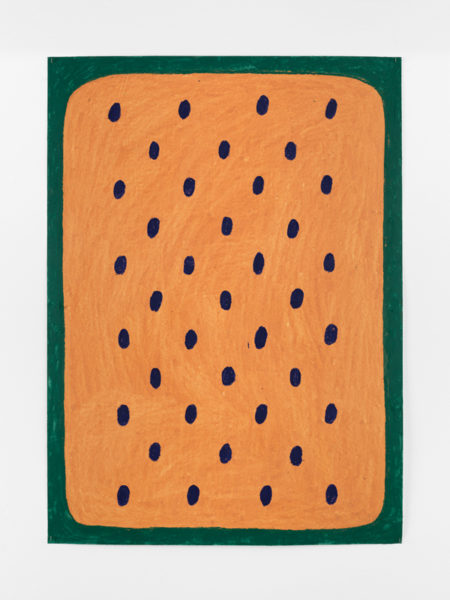
DS: What’s next for you after the Essex Flowers exhibition?
I’m really excited about the solutions I came up with in my work that’s up at Essex Flowers right now. Not everything I am showing is resolved but that’s actually a good thing. If everything was resolved, I’d have no reason to go back to the studio. While working on this body of work, I discovered a lot of techniques and ideas that I’m eager to keep working on. I’m honestly more excited about that than any kind of accolades or a next show on the calendar.
RACHEL DOMM is a Brooklyn-based artist. Her work has been shown in solo exhibitions at Picture Room (2014) and Printed Matter (2013) and group exhibitions at Essex Flowers and Exit Art. She has held residencies at the Banff Centre and the Vermont Studio Center. She has published several artist books including Window Diary (Nieves, 2015), Baskets (Miniature Garden, 2015) and Rugs (Miniature Garden, 2013).
ESSEX FLOWERS is an artist-run cooperative gallery located at 19 Monroe, New York, NY in the Chinatown neighborhood of Manhattan. The gallery is open Saturdays and Sundays, 12 – 6 PM, and by appointment. Domm’s work is on view until February 11, 2018.
